
Tree 18m tall in town of El Salto, Durango [C.J. Earle, 2007.02.10].
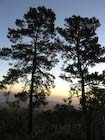
Trees about 20 m tall on the lower E slopes of Nevado de Colima, Michoacán [C.J. Earle, 2005.02.14].
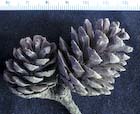
Cones collected near Chalma on the road to Cuernavaca [C.J. Earle, 2005.02.12].

070215-08e Saplings of P. devoniana (left) and P. leiophylla (right), the taller ca 8m. Near Patzcuaro, Michoacán [C.J. Earle, 2007.02.15].
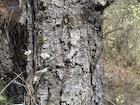
Bark on a tree 20 cm in diameter [C.J. Earle, 2005.02.05].
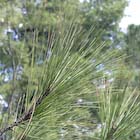
Foliage [C.J. Earle, 2005.02.05].

Stand near Uruapan, Michoacán [Robert Van Pelt, 2005.02].
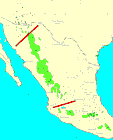
Distribution of P. leiophylla. The red bars mark the zone of overlap between subsp. leiophylla to the south and subsp. chihuahuana to the north. Map based on Critchfield and Little (1966) with subspecies demarcated on the basis of Farjon and Styles (1997).

Pinus leiophylla subsp. leiophylla
Common names
Ocote blanco.
Taxonomic notes
Synonymy, from Farjon (1998):
- P. cedrus Roezl 1857
- P. comonfortiii Roezl 1857
- P. decandolleana Roezl 1857
- P. dependens Roezl 1857
- P. decandolleana var. dependens (Roezl) Carr. 1867
- Pinus gracilis Roezl 1857
- P. comonfortiii var. gracilis (Roezl) Carr. 1867
- P. huiquilucaensis Roezl 1857
- P. lerdoi Roezl 1857
- P. comonfortiii var. lerdoi (Roezl) Carr. 1867
- P. monte-allegri Roezl 1857
- P. comonfortiii var. monte-allegri (Roezl) Carr. 1867
- P. verrucosa Roezl 1857
- P. decandolleana var. verrucosa (Roezl) Carr. 1867
- P. lumholtzii Robinson et Fernald var. microphylla Carvajal 1986
See Pinus montezumae for remarks on Roezl's creative approach to pine systematics.
Description
See the description for the species. This subspecies has more restricted characters as follows: leaves chiefly in fascicles of 5, 0.5-0.9 mm wide, with 4-6 lines of stomata on the abaxial face and 2-3 resin ducts (Farjon and Styles 1997).
Distribution and Ecology
Mexico: Sonora, Chihuahua, Durango, Nayarit, Zacatecas, Jalisco, Michoacán, México, Distrito Federal, Hidalgo, Morelos, Tlaxcala, Puebla, Veracruz, Guerrero, and Oaxaca. From Zacatecas northward it is gradually replaced by subsp. chihuahuana. It is a common species, found at (1500-)1900-2900(-3300) m elevation in montane to high montane pine and pine-oak forests, normally on deep, well-drained soils. Commonly associated species include Quercus spp., Pinus patula, P. pringlei, P. teocote, P. lawsonii, P. pseudostrobus, P. montezumae, P. douglasiana, P. durangensis, and P. oocarpa. Near the north end of its range, it is found with P. arizonica, P. engelmannii, and P. leiophylla subsp. chihuahuana. It may also be found with Juniperus spp., Hesperocyparis lusitanica, or Hesperocyparis arizonica (Farjon and Styles 1997).
Remarkable Specimens
Ethnobotany
Observations
Within its range, this is a common species, occurring at a wide range of elevations and in the company of numerous other pine species. It is common along highway Mex-16 in Sonora from where you first enter the mountains about 80 km E of Hermosillo until the Chihuahua border, by which time it has largely given way to subsp. chihuahuana. The next major highway crossing the Sierra Madre Occidental is Mex-40 from Durango to Mazatlán, and here a forest of P. cembroides, P. pseudostrobus, and P. leiophylla subsp. chihuahuana prevails until about where the first P. durangensis appear, and thereafter subsp. leiophylla is common until you approach the Durango-Sinaloa border, by which time things are warm and wet enough that P. leiophylla gives way to pines like P. montezumae, P. maximinoi and P. lumholtzii. Throw in a few less common pines, Abies durangensis and some rare Juniperus species, and a conifer lover could scarcely do better than to take a few days to travel from Durango to Mazatlán. Farther south, subsp. leiophylla is very common in Michoacán, on the Nevado de Colima (another conifer hotspot) and in the country between Uruapan and Morelia (yet another), and is also a common species E across the volcanic plateau through México, the D.F. and into Puebla. I have heard a rumor of subsp. leiophylla growing to heights of 50 m in Parque Nacional Los Leones west of the Distrito Federal, but I have yet to check it out. I also saw it sporadically on highway Mex-175 N of Oaxaca Ciudad.
Remarks
This species is a principal host for the dwarf mistletoe Arceuthobium nigrum, and is the only common host for A. strictum (Hawksworth and Wiens 1996).
Citations
See also








